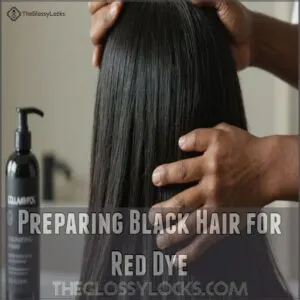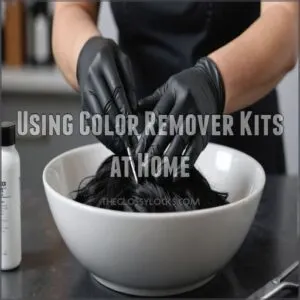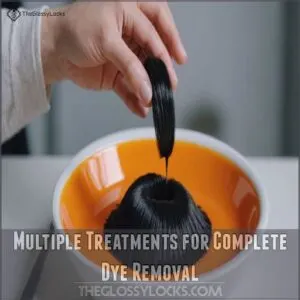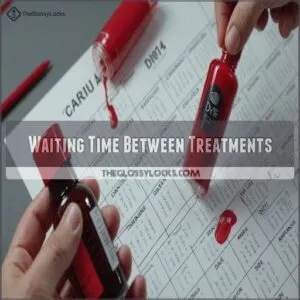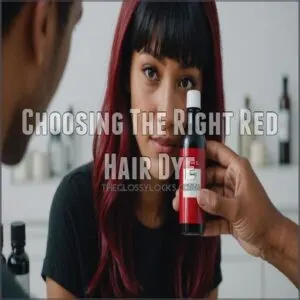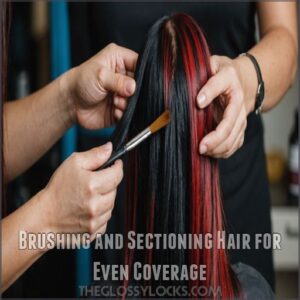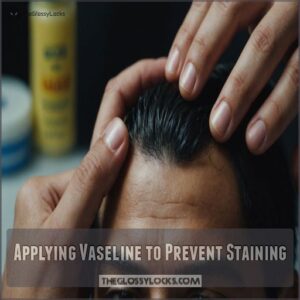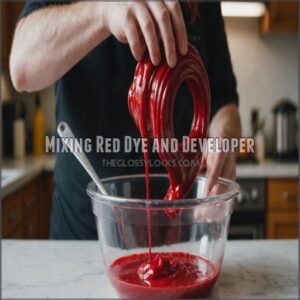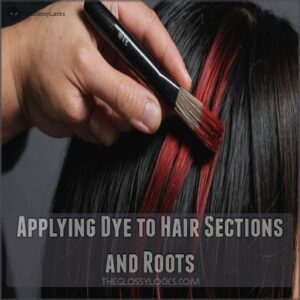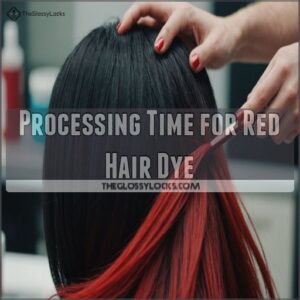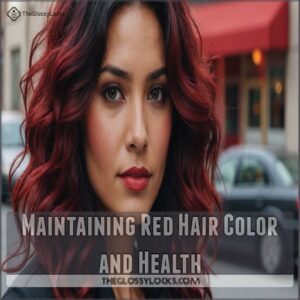This site is supported by our readers. We may earn a commission, at no cost to you, if you purchase through links.
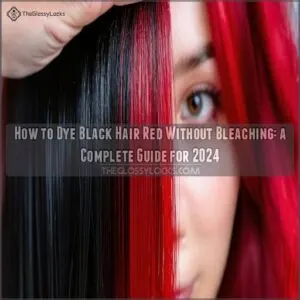
L’Oreal HiColor Highlights and similar dyes contain powerful pigments that penetrate dark strands.
First, wash your hair with clarifying shampoo to remove buildup.
Mix your chosen red dye with a 30-volume developer, section your hair carefully, and apply the mixture from roots to tips.
Let it process for 45 minutes.
For best results, avoid washing your hair for 48 hours after dyeing.
While the change won’t be as dramatic as bleached results, you’ll achieve a rich, dimensional red that’s uniquely yours.
Table Of Contents
- Key Takeaways
- Preparing Black Hair for Red Dye
- Removing Black Hair Dye Without Bleach
- Choosing The Right Red Hair Dye
- Applying Red Hair Dye for Optimal Results
- Maintaining Red Hair Color and Health
- Frequently Asked Questions (FAQs)
- Can black hair be dyed red without using bleach?
- How to treat hair whitening naturally?
- How to dye your hair at home without bleach?
- How do I make my hair red if I dyed black?
- What color hair can you dye without bleaching?
- Can I dye my hair if it has been dyed black?
- How long does red dye last on black hair?
- Can I mix different red dyes together?
- Should I dye my hair wet or dry?
- Will red dye show up differently on graying hair?
- What should I do if my scalp gets irritated?
- Conclusion
Key Takeaways
- You’ll need clarifying shampoo and hot water treatments to prep your hair, gently removing existing color buildup.
- You should use a high-lift red dye specifically formulated for dark hair, avoiding bleach for a gentler process.
- You’ll want to protect your skin with petroleum jelly and section your hair for even dye application.
- You must maintain your new red hair with color-safe products and deep conditioning to keep it vibrant and healthy.
Preparing Black Hair for Red Dye
You’ll need to prep your black hair properly before transforming it to red, which involves using clarifying shampoo and hot water treatments to gently strip away existing color.
You’ll need to prep your black hair properly before transforming it to red, which involves using clarifying shampoo and hot water treatments to gently strip away existing color.
Your next step is applying a deep conditioning treatment overnight to protect your hair during the color removal process, ensuring your strands stay healthy and ready for the red dye application.
Using Clarifying Shampoo to Fade Black Dye
Ready to fade that black dye?
Start with a clarifying shampoo designed for color-treated hair.
Apply it 2-3 times weekly, massaging thoroughly into your scalp and strands.
Professional-grade options like Neutrogena Clean Balance or Paul Mitchell Clarifying Three can speed up the fading process.
Keep in mind that while this method is gentle, you’ll need patience—expect to see noticeable results after 3-4 weeks of consistent use.
Hot Water to Open Hair Cuticles
Hot water opens your hair cuticles like venetian blinds, letting the dye slip away more easily.
While clarifying shampoo strips away buildup, hot water goes deeper.
You can even use a red dye for black hair specifically designed for this purpose.
Here’s how to use heat effectively:
- Start with warm water to soften hair strands
- Gradually increase temperature to as hot as comfortable
- Massage scalp in circular motions for 5 minutes
Just remember: don’t make it scalding – you want open cuticles, not damaged ones.
Deep Conditioning Overnight for Dye Removal
For better dye removal, deep conditioning overnight works wonders.
When applying a deep conditioning mask, use around 2-4 oz of conditioner for waist-length hair, adjusting the amount based on your hair thickness as explained in waist-length hair deep conditioning.
Apply a rich conditioning mask from roots to tips, focusing on damaged areas.
Here’s what different masks can do:
| Mask Type | Benefits | Best For |
|---|---|---|
| Coconut Oil | Penetrates deeply | Brittle hair |
| Argan Oil | Adds shine | Frizzy hair |
| Keratin | Strengthens | Damaged hair |
Wrap your hair in a shower cap and let the treatment work its magic while you sleep.
Choosing The Right Color Removing Product
While deep conditioning helps prep your hair, selecting the right color remover is your next power move.
Look for non-bleach color removers like Color Oops or One ‘n Only Colorfix – they’re gentler than bleach but still effective.
Consider your hair type: fine hair needs milder formulas, while coarse hair might need stronger ones.
Always do a patch test first to avoid unwanted surprises.
Removing Black Hair Dye Without Bleach
You’ll need color remover kits to strip away black hair dye without using harsh bleach.
The process usually takes multiple treatments for complete removal.
With proper timing between treatments and the right products, you can safely remove the black dye while keeping your hair healthy enough for your future red shade.
Using Color Remover Kits at Home
Color remover kits offer a gentler alternative to bleach when transforming your black hair.
To find the best color remover kit for your hair type, you can check out a website that sells products related to Color remover kit.
Before diving in, here’s what you need for a successful at-home removal session:
- A quality color remover kit with both the remover and activator
- Protective gloves and an old towel to prevent stains
- A plastic or glass mixing bowl (metal bowls can react with chemicals)
Mix the solution according to package instructions, and apply it evenly from roots to tips.
Multiple Treatments for Complete Dye Removal
Patience pays off when removing stubborn black dye from your hair.
You’ll likely need 2-3 applications of color remover to completely strip the dark pigments.
Each treatment gradually lifts more color, revealing lighter undertones.
Watch your hair’s condition between sessions – if it feels dry or brittle, deep condition it.
For best results, consider alternating between different types of color removers.
Waiting Time Between Treatments
Give your hair a break between color removal treatments to maintain its health and prevent damage.
Here are key tips for timing your treatments:
- Wait at least 24 hours between using color removers
- Monitor your scalp for any irritation or sensitivity
- Allow 3-4 days if your hair feels particularly dry or brittle
- Consider a week-long break if you notice excessive shedding
- Use deep conditioning treatments during waiting periods
Choosing The Right Red Hair Dye
You’ll want to pick a red hair dye that’s 1-2 shades lighter than your desired result, since your hair will be more receptive to color after removing the black dye.
Your skin tone plays a key role in finding your perfect shade, with cool undertones matching well with velvet and mahogany reds, while warm undertones look best with auburn and burgundy shades.
Selecting a Red Shade Based on Skin Tone
Now that you’ve removed the black dye, finding your perfect red shade starts with understanding your skin tone.
Before grabbing that tempting fire-engine red, you can explore a wide range of red hair dye options for dark hair available online, such as those at red hair dye products.
Take a quick look at your wrist veins and natural lip color. These natural markers will guide you toward reds that’ll make you glow, not wash you out.
Your skin’s undertone is like a built-in color consultant.
Cool Skin Tones and Red Hair
Looking in the mirror and seeing pink, red, or bluish undertones in your skin? You’ve got cool undertones.
Your best red hair choices include deep velvet reds, rich mahogany, and aubergine shades.
These cooler-toned reds complement your natural coloring without clashing.
For the most flattering result, stick to jewel-toned reds with blue or purple bases rather than orange-based shades.
Warm Skin Tones and Red Hair
After mastering cool-toned reds, let’s explore shades that make warm skin tones glow.
Your peachy or golden undertones create the perfect canvas for vibrant reds that’ll turn heads.
- True red brings out the warmth in your complexion, creating a stunning contrast
- Dark auburn adds richness while complementing golden undertones
- Burgundy offers sophisticated depth for olive skin
- Copper-red highlights naturally enhance your warm features
These shades work magic with your complexion’s natural warmth, making your whole look come alive.
Fair Skin and Red Hair
For those with fair skin, lighter shades of red can create a stunning, natural-looking result.
You’ll want to lean toward copper tones, strawberry blonde, or light auburn shades that complement your complexion without overpowering it.
Think Emma Stone’s signature look – it’s the perfect example of how a softer red can enhance fair skin while avoiding that artificial, too-bold appearance that might wash you out.
Dark Skin Tones and Red Hair
Dark skin tones create a stunning backdrop for bold red hair colors.
Rich shades like fire engine red, blackberry, and violet red make a powerful statement against deeper complexions.
You’ll rock burgundy or burnt orange tones that bring out your skin’s natural warmth.
Many celebrities, like Rihanna and SZA, have showcased these vibrant red looks.
Your melanin-rich complexion lets you experiment with the most daring red shades confidently.
Applying Red Hair Dye for Optimal Results
You’ll need to prep your hair properly before applying red dye, including sectioning it carefully and protecting your skin with petroleum jelly to prevent stains.
With your tools ready and your hair sectioned into manageable parts, you can mix your chosen red dye with developer and start the transformation process that’ll give you that perfect shade of red.
Brushing and Sectioning Hair for Even Coverage
Getting ready to apply red dye? Start by taking total control over your hair’s destiny.
Divide your mane into manageable sections using sectioning clips – think of creating a hot cross bun pattern on your head.
Use a wide-toothed comb to gently detangle each section from bottom to top.
This method guarantees no strand gets overlooked and your new red shade will look flawless.
Applying Vaseline to Prevent Staining
Before diving into the dye application, protect your skin from stubborn stains by creating a protective barrier with Vaseline.
Be aware that Vaseline can be difficult to remove from hair, and consider methods to remove Vaseline from hair if it accidentally gets on your locks.
Apply a generous layer around your hairline, ears, and neck where dye commonly leaves marks.
Here’s where to apply Vaseline:
- Along your entire hairline, including the nape
- Behind and around your ears
- Down the sides of your neck
- On any exposed scalp patches
Mixing Red Dye and Developer
Now that your hairline is protected, let’s master the mixing process.
Pour your red dye into a plastic mixing bowl and add developer at a 1:2 ratio (one part dye to two parts developer).
Mix until you achieve a smooth, yogurt-like consistency.
Stick with a 30-volume developer for dark hair – it’ll give you the lift needed without excessive damage.
Remember, no metal bowls!
Applying Dye to Hair Sections and Roots
Many stylists recommend dividing your hair into four equal sections using clips.
Start applying the dye mixture from the back sections, working your way forward.
Take thin, manageable slices within each section and saturate them thoroughly with dye using your application brush.
Once you’ve covered the lengths, focus on your roots, ensuring even coverage along your hairline and behind your ears.
Processing Time for Red Hair Dye
While timing varies based on your hair type and desired shade, most red dyes need 30-45 minutes to fully develop.
Keep an eye on your hair during processing – when you see the color intensifying to your target shade, it’s time to check a small section.
For resistant grays or stubborn black dye, you might need the full 45 minutes to achieve the richest red results.
Maintaining Red Hair Color and Health
You’ll need to take special care of your newly dyed red hair to keep its vibrant color and prevent damage from the dye process.
Your commitment to proper maintenance will give you long-lasting, healthy red hair that turns heads and stays gorgeous between touch-ups.
Washing and Conditioning Red Hair
After your fresh red transformation, proper washing habits make all the difference.
Use color-safe red shampoo 2-3 times weekly – not daily, as overwashing speeds up fading.
Rinse with cool water to seal those hair cuticles and lock in color.
Follow up with a color-protecting conditioner, focusing on your ends.
For extra vibrancy, try a weekly deep conditioning mask with red pigments.
Using Dry Shampoo and Heat Protectants
Between frequent washes, dry shampoo becomes your secret weapon against color fade, absorbing excess oil without stripping your red hue.
Spray it 6 inches from your roots, let it sit for 2 minutes, then massage and brush through.
For styling, always apply a heat protectant before using hot tools – aim for products containing ingredients like argan oil or keratin to shield your color investment.
Deep Conditioning for Hair Health
Deep conditioning transforms your newly-dyed red hair into a silky masterpiece.
Apply a protein-rich hair mask weekly to lock in moisture and prevent color fade.
Natural oils like coconut or argan work wonders when left overnight – just wrap your hair in a silk scarf to protect your pillowcase.
For an extra boost, mix honey with your regular conditioner to create a DIY treatment that keeps your red vibrant.
Touch-Ups With Semi-Permanent Dye
Maintaining your vibrant red hue doesn’t have to be a constant battle.
Semi-permanent dye offers a gentle way to refresh your color between permanent treatments, giving you more control over fading and touch-ups.
- Apply semi-permanent dye every 2-3 weeks to maintain intensity
- Mix the dye with conditioner for a more subtle refresh
- Focus application on the most faded areas first, typically around the face and ends
Frequently Asked Questions (FAQs)
Can black hair be dyed red without using bleach?
Yes, you can dye black hair red without bleach by using high-lift dyes designed for dark hair colors.
Although results may vary, achieving a vibrant red may require several applications and careful use of color-protecting products.
How to treat hair whitening naturally?
To treat hair whitening naturally, try massaging your scalp with coconut oil mixed with curry leaves or amla (Indian gooseberry) powder.
A balanced diet rich in vitamins and minerals, especially B12 and omega-3s, may help.
How to dye your hair at home without bleach?
Afraid of damage from bleach?
Try a permanent red dye made for dark hair.
Use L’Oreal Excellence HiColor with a Level 30 developer.
Follow the instructions, and protect your skin with petroleum jelly to avoid stains.
How do I make my hair red if I dyed black?
Ditch the black locks for fiery red hair by first removing existing color with a color remover or bleach.
Then apply a chosen red shade.
What color hair can you dye without bleaching?
You can dye hair in shades like dark brown, burgundy, or red without bleaching.
These colors often adhere well to darker natural tones, giving you vibrant results without the need for potentially damaging bleaching processes.
Can I dye my hair if it has been dyed black?
Rome wasn’t built in a day," so take your time.
Yes, you can dye previously dyed black hair, but it’s tricky.
Professional help is often best, especially for dramatic color changes.
Consider a color remover or multiple sessions for the best results.
How long does red dye last on black hair?
Red dye on black hair without bleach usually lasts 3-4 weeks before noticeable fading begins.
Expect to retouch color every 4-6 weeks to maintain vibrancy, using color-safe shampoos to extend its lifespan and reduce fading.
Can I mix different red dyes together?
Mixing different red dyes is possible, but test a small swatch first to make sure a harmonious blend.
This approach allows you to customize your shade, offering creativity and control over the final hair color outcome.
Should I dye my hair wet or dry?
Dyeing your hair dry usually results in a more even color application.
Wet hair can dilute the dye, leading to uneven color, especially with bold shades like red.
Dry locks help you achieve vibrant, consistent results.
Will red dye show up differently on graying hair?
Graying hair can absorb red dye unevenly, leading to varied shades.
It might blend the red with natural gray for a unique tone.
Mixing conditioner with dye or using demi-permanent color can offer better consistency.
What should I do if my scalp gets irritated?
If your scalp gets irritated, rinse with cool water and apply a soothing aloe vera gel or hydrocortisone cream.
Avoid styling products and heat tools temporarily.
If irritation persists, consult a dermatologist for further advice.
Conclusion
Transforming your black hair to red without bleaching is like painting a canvas with vivid colors without altering its base.
By using specialized products and following the steps carefully, you can achieve a stunning, vibrant red hue.
Remember to prepare your hair, choose the right red dye, and take care of your colored locks.
This guide on how to dye black hair red without bleaching makes sure you get bold results while keeping your hair healthy and beautiful.

